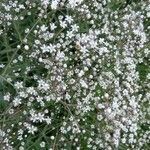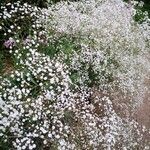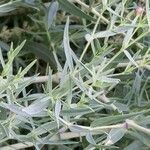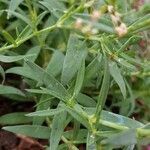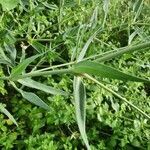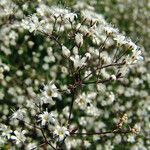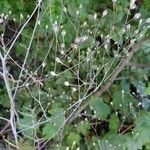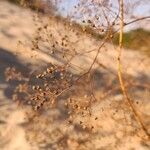Herb, perennial, with long, glandular hairs near the base, glabrous above. Stems several, erect or ascending from the base, 60–90 cm high, sometimes taller. Leaves sessile, linear-lanceolate, acuminate, ± glaucous, 10–50 mm long, 1–5 mm wide. Inflorescence a large, many-flowered panicle; bracts herbaceous below, scarious above. Pedicels 2–6 mm long. Calyx campanulate, c. 2 mm long; calyx lobes broadly ovate, obtuse, with broad, scarious margins, slightly shorter than tube. Petals linear-spathulate, 2–4 mm long, obtuse, white to pale pink. Styles 2. Capsule subglobose, c. 3 mm long. Seeds 1.5–1.7 mm long, black, bluntly tuberculate.
Perennial, usually glabrous, glaucous herb with stout, deep root-system. Stems up to 90 cm, diffusely branched, in lower part quadrangular, hairy, upwards glabrous. Leaves narrowly elliptic, acute or acuminate, 20-70 by 3-20 mm. Inflorescence a richly branched panicle with numerous small flowers; bracts linear-narrowly elliptic, small; pedicels up to 4 mm. Calyx 1-2.5 mm, divided halfway down, teeth ovate, obtuse with broad scarious margin. Petals white or pink, 3-4 mm, linear-spathulate, at last reflexed. Capsule ± spherical, about as long as the calyx. Seeds light brown with obtuse tubercles, 0.3-0.4 mm.
Perennial with thick root. Flowering stems erect, glabrous or hairy near base, branching, (30)-40-100 cm tall. Lvs narrow-lanceolate to linear-lanceolate, acute to acuminate, glabrous, glaucous, (10)-20-50 × 1-5 mm. Infl. a large, dichasial panicle with > 100 fls. Bracts deltoid, acute to acuminate, glabrous; margins scarious. Calyx widely bell-shaped, glabrous, 1.5-2 mm long, divided to c. 1/2 way; teeth ovate, rounded with broad scarious margins. Petals white or pink, = or slightly > calyx, entire or truncate. Styles exserted, spreading. Capsule globose, slightly > calyx. Seeds 1-1.5 × 1-1.5 mm, warty.
Plants perennial. Stems erect or ± sprawling, diffusely much-branched at or near crown, 4-10 dm, glabrous or occasionally glandular-puberulent or scabrous near base. Leaves cauline, bases not clasping; blade linear-lanceolate to oblong-lanceolate, larger leaves 2-9 cm × 2-10 mm, apex acute to acuminate, glaucous. Pedicels 1-20 mm, glabrous. Flowers: calyx 1-3 mm, lobes glabrous, apex rounded to obtuse; petals white or rarely light purplish pink, 1-4 mm. Capsules globose. Seed coats coarsely tuberculate. 2n = 34, 68 (both Europe).
Diffusely branched perennial, mostly 4–10 dm, glabrous and glaucous, or the stem somewhat scabrous below; lvs lanceolate, acuminate, 2–7 cm × 2.5–10 mm, not clasping; pedicels and cal glabrous, the cal 1.5–2 mm; pet 2–4 mm, white or pale reddish; capsule globose; 2n=34. Native of Europe, cult. and occasionally escaped in our range. Summer.
A herb. It keeps growing from year to year. The roots are stout. There is a single stem. It grows 30-80 cm tall. The leaves are sword shaped or narrow and 2-5 cm long by 3-7 mm wide.
